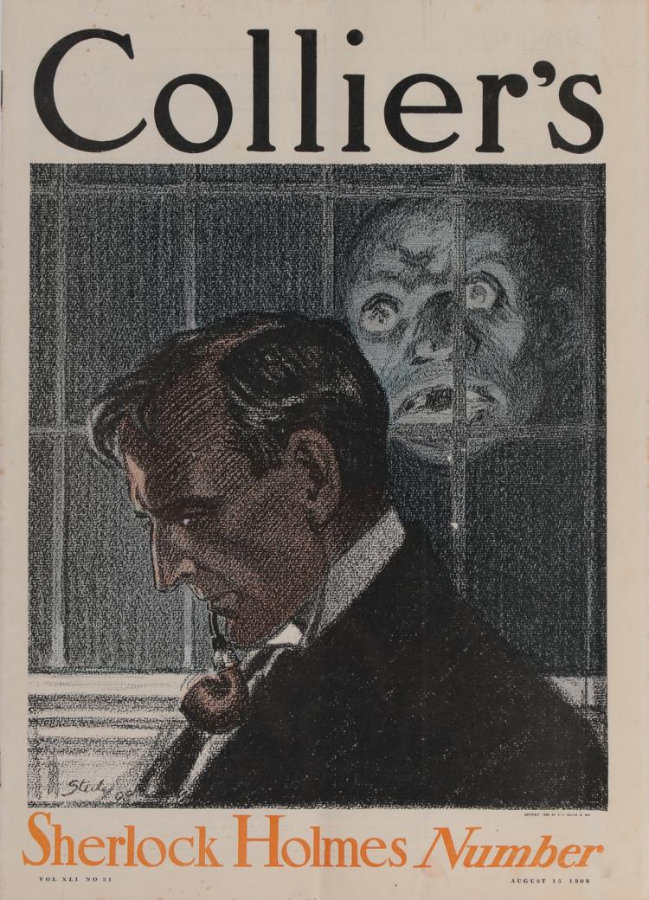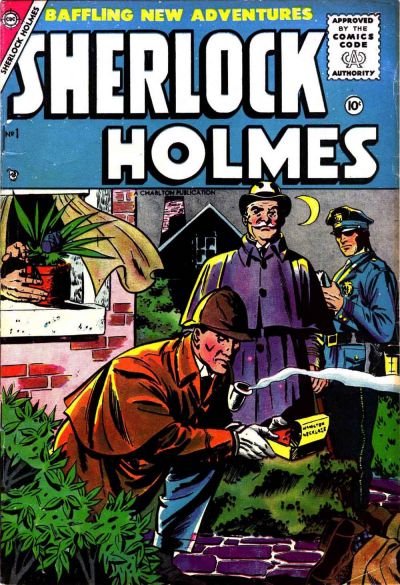Sherlock Holmes is a “consulting detective” in stories by British author Arthur Conan Doyle. Holmes is known for his proficiency with observation, deduction, forensic science and logical reasoning that borders on the fantastic, which he employs when investigating cases for a wide variety of clients, including Scotland Yard. First appearing in print in 1887’s “A Study in Scarlet”, the character’s popularity became widespread with the first series of short stories in The Strand Magazine, beginning with “A Scandal in Bohemia” in 1891; additional tales appeared from then until 1927, eventually totalling four novels and 56 short stories. All but one are set in the Victorian or Edwardian eras, between about 1880 and 1914. Most are narrated by Holmes’s friend and biographer Dr. John H. Watson, who usually accompanies Holmes during his investigations and often shares quarters with him at the address of 221B Baker Street, London, where many of the stories begin. Watson describes Holmes as “bohemian” in his habits and lifestyle. Said to have a “cat-like” love of personal cleanliness, at the same time Holmes is an eccentric with no regard for contemporary standards of tidiness or good order. Watson describes him as “in his personal habits one of the most untidy men that ever drove a fellow-lodger to distraction. [He] keeps his cigars in the coal-scuttle, his tobacco in the toe end of a Persian slipper, and his unanswered correspondence transfixed by a jack-knife into the very centre of his wooden mantelpiece. … He had a horror of destroying documents…. Thus month after month his papers accumulated, until every corner of the room was stacked with bundles of manuscript which were on no account to be burned, and which could not be put away save by their owner.” While Holmes can be dispassionate and cold, during an investigation he is animated and excitable. He has a flair for showmanship, often keeping his methods and evidence hidden until the last possible moment so as to impress observers. His companion condones the detective’s willingness to bend the truth (or break the law) on behalf of a client—lying to the police, concealing evidence or breaking into houses—when he feels it morally justifiable. Except for that of Watson, Holmes avoids casual company. In “The Gloria Scott”, he tells the doctor that during two years at college he made only one friend. The detective goes without food at times of intense intellectual activity, believing that “the faculties become refined when you starve them.” At times Holmes relaxes with music, either playing the violin, or enjoying the works of composers such as Wagner and Pablo de Sarasate. Though not the first fictional detective, Sherlock Holmes is arguably the best known. By the 1990s, there were already over 25,000 stage adaptations, films, television productions and publications featuring the detective, and Guinness World Records lists him as the most portrayed literary human character in film and television history. Avid readers of the Holmes stories helped create the modern practice of fandom. The character and stories have had a profound and lasting effect on mystery writing and popular culture as a whole, with the original tales as well as thousands written by authors other than Conan Doyle being adapted into stage and radio plays, television, films, video games, and other media for over one hundred years.
| Alias Sherlock Holmes |
| Real Names/Alt Names Sherlock Holmes |
| Characteristics Hero, Detective, International Society of Infallible Detectives, Literary Characters, Wold Newton Universe, Realism and Victorian Age, British |
| Creators/Key Contributors Sir Arthur Conan Doyle |
| First Appearance “A Study in Scarlet” serialized in Beeton’s Christmas Annual (1887) |
| First Publisher George Newnes, Ltd. |
| Appearance List Novels: A Study in Scarlet (1887), The Sign of the Four (1890), The Hound of the Baskervilles (1901–1902), The Valley of Fear (1914–1915). The 56 short stories are collected in five books: The Adventures of Sherlock Holmes (1892, with original illustrations by Sidney Paget), The Memoirs of Sherlock Holmes (1894), The Return of Sherlock Holmes (1905), His Last Bow (1917), The Case-Book of Sherlock Holmes (1927). Over 25,000 stage adaptations, films, television productions and publications, including comics. |
| Sample Read The Memoirs of Sherlock Holmes (1894) [Internet Archive] |
| Description Sherlock Holmes is a “consulting detective” in stories by British author Arthur Conan Doyle. Holmes is known for his proficiency with observation, deduction, forensic science and logical reasoning that borders on the fantastic, which he employs when investigating cases for a wide variety of clients, including Scotland Yard. First appearing in print in 1887’s “A Study in Scarlet”, the character’s popularity became widespread with the first series of short stories in The Strand Magazine, beginning with “A Scandal in Bohemia” in 1891; additional tales appeared from then until 1927, eventually totalling four novels and 56 short stories. All but one are set in the Victorian or Edwardian eras, between about 1880 and 1914. Most are narrated by Holmes’s friend and biographer Dr. John H. Watson, who usually accompanies Holmes during his investigations and often shares quarters with him at the address of 221B Baker Street, London, where many of the stories begin. Watson describes Holmes as “bohemian” in his habits and lifestyle. Said to have a “cat-like” love of personal cleanliness, at the same time Holmes is an eccentric with no regard for contemporary standards of tidiness or good order. Watson describes him as “in his personal habits one of the most untidy men that ever drove a fellow-lodger to distraction. [He] keeps his cigars in the coal-scuttle, his tobacco in the toe end of a Persian slipper, and his unanswered correspondence transfixed by a jack-knife into the very centre of his wooden mantelpiece. … He had a horror of destroying documents…. Thus month after month his papers accumulated, until every corner of the room was stacked with bundles of manuscript which were on no account to be burned, and which could not be put away save by their owner.” While Holmes can be dispassionate and cold, during an investigation he is animated and excitable. He has a flair for showmanship, often keeping his methods and evidence hidden until the last possible moment so as to impress observers. His companion condones the detective’s willingness to bend the truth (or break the law) on behalf of a client—lying to the police, concealing evidence or breaking into houses—when he feels it morally justifiable. Except for that of Watson, Holmes avoids casual company. In “The Gloria Scott”, he tells the doctor that during two years at college he made only one friend. The detective goes without food at times of intense intellectual activity, believing that “the faculties become refined when you starve them.” At times Holmes relaxes with music, either playing the violin, or enjoying the works of composers such as Wagner and Pablo de Sarasate. Though not the first fictional detective, Sherlock Holmes is arguably the best known. By the 1990s, there were already over 25,000 stage adaptations, films, television productions and publications featuring the detective, and Guinness World Records lists him as the most portrayed literary human character in film and television history. Avid readers of the Holmes stories helped create the modern practice of fandom. The character and stories have had a profound and lasting effect on mystery writing and popular culture as a whole, with the original tales as well as thousands written by authors other than Conan Doyle being adapted into stage and radio plays, television, films, video games, and other media for over one hundred years. |
| Source Sherlock Holmes – Wikipedia |







